#eventually you get the revelatory breakdown
Explore tagged Tumblr posts
Text
24 hours ago I liked a ship in a real “I just think their neat” vibe but then I had Revelations about it and it’s suddenly turned into a brain rot mix of “oh my god why did you half ass this so badly in canon” and “oh my god there’s so little in canon I can twist it however I want in fanfics” because both characters got the bare minimum character development after the halfway point in the manga with minimal backstories.
So that’s fun.
That’s really what I needed more and different brain rots to the ones I already had.
#fanfiction#fanfic#fanfic writer#not sure if I’m gonna tag the ship or the fandom#to hell with it#it’s My Hero Academia#Itsuka/Momo#their vibe was on point#then I realised their designs are like inverses of each other#Momo’s got the smooth dark coloured spiky ponytail and Itsuka has the bright rough one#Momo has the super complicated quirk she had to study to use effectively#and Itsuka has the brutally simple quirk that she’s trained everything to use effectively#Itsuka loves coffee and Momo loves tea#Itsuka is purely hand to hand and Momo keeps getting net guns and stuff#this is the true rivals to lovers ship Horikoshi should’ve done#Momo has rich girl vibes and Kendo has brutally middle of middle class vibes#this is why vibe shipping is great#eventually you get the revelatory breakdown#also has the bi4bi vibes#they’re gonna need their own fic eventually and not just be part of one of the two polycules in wings#Jackattack rambles
2 notes
·
View notes
Text
Battle Tendency Liveblog: JJBA Ch. 88-93
Hey, guess what this post is all about? Here’s a hint:
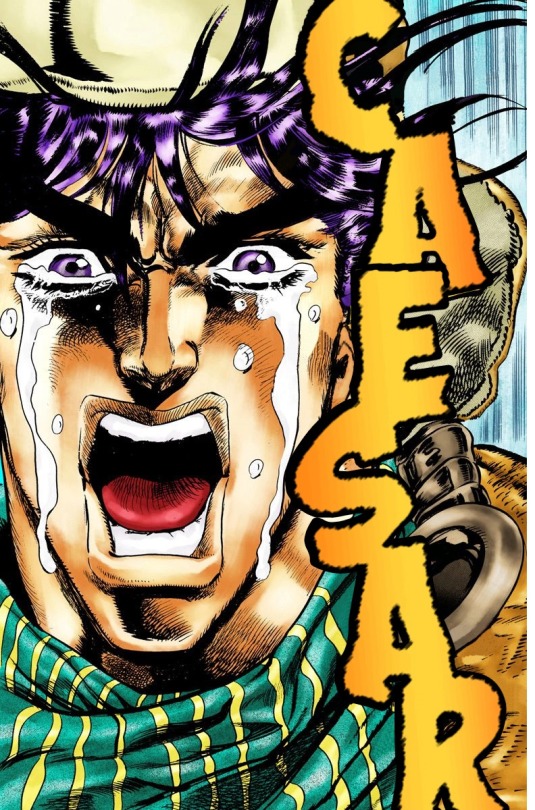
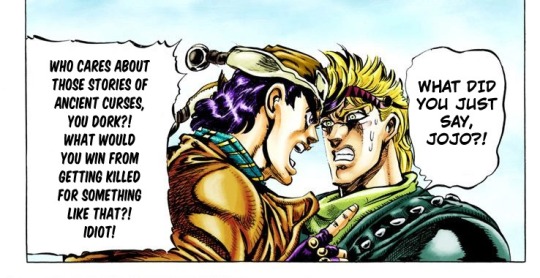
In St. Moriz, Switzerland, the gang have tracked down the address to which Esidisi had tried to mail the Red Stone of Aja. Turns out it’s some spooky abandoned mansion with all the windows boarded up. It’s the perfect hideout for a supervillain who doesn’t want to be bothered by nosy neighbors or pesky sunlight.
Actually, now that I think about it, I’m not sure why Esidisi expected the mailman to deliver his package to an empty building. Maybe he figured Kars could just barge into the St. Moriz post office and find it.
Another weird thing: Joseph opens this chapter with a monologue about the setting, then teases a cat, then provides exposition about the poison ring on his heart, and then Lisa Lisa calls him over to check out the mansion they’ve found. It seems kind of strange that he was just monologueing the whole time, unless that’s supposed to be the joke.
Anyway, now they have to figure out their next move. Caesar wants to go to the manion at once to attack Kars before sundown. They know he’s in there, and he’s alone, because he said Wammu was away during their last encounter. So it’ll be four on one, and they’ll have the advantage because the sun’s out. But Joseph disagrees. Kars has lived like this for thousands of years. He would be expecting his enemies to attack him during the day, and it’s a safe bet that he’s laid all sorts of traps and precautions to protect himself. So why play into his hands? Joseph wants to wait, although I’m not sure attacking at night would be any easier. Maybe he wants the Pillar Men to come to them?
Actually, that makes a lot of sense. Joseph has to fight Wammu in about five days, in order to get the antidote to the poison ring. They have the Aja Stone, so maybe it makes sense to play keep-away until the big Joseph/Wammu fight. Joseph can kill Wammu (hopefully), and that leaves Kars isolated. From there on, they can stick together, and wait for Kars to come to them, confident that their combined power can defeat him. There’s a lot that could go wrong with such a strategy, but it minimizes the risks.
But Caesar is adamant about going after Kars immediately. They know where he is, so how can they wait another moment? He speaks of the curse of the Stone Mask, that got their grandfathers killed, but Joseph finds that talk dumb. Family legacies don’t mean anything against your own life in the here and now. It’s stupid to get killed over something like that, he says, and that pisses Caesar off.
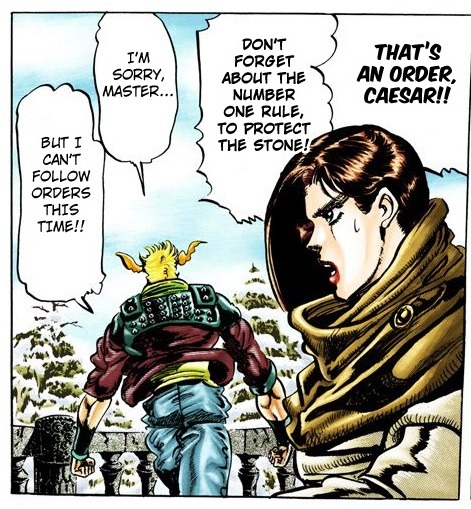
He fights with Joseph, then angrily goes off to storm Kars’ lair alone. I could show the part where he fights Joseph, but I think this panel is a lot more powerful, because Lisa Lisa orders him to stay, and he defies her. Caesar’s always held Lisa Lisa in such high regard, but this time, he just can’t respect her wishes. She orders Messina to follow him and stop him before he can go inside the mansion, then explains to Joseph why this is so important to Caesar.
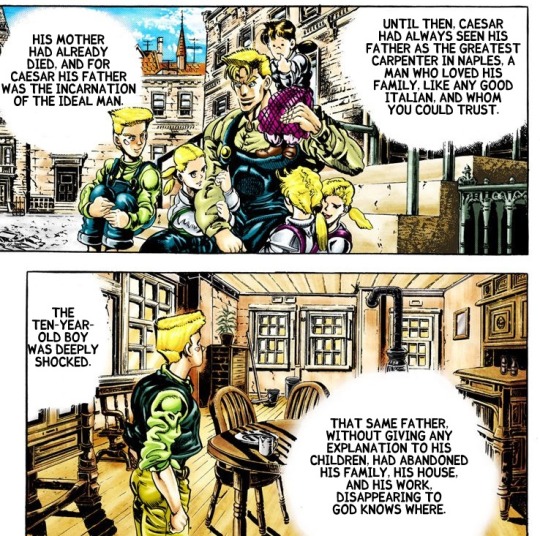
Okay, to this whole Caesar Fights Alone arc is extremely full of “rhymes” with other JoJo parts. Let me just get a couple out of the way before we get down to business. The Part 1 references in Battle Tendency should be obvious, but in this case, Will Zeppeli has everything to do with Caesar’s determination to kill Kars. Also, when discussing an attack on the mansion, Joseph likens a daylight assault to “a butterly landing on a spider’s web”, which is Jolyne Kujo’s entire wardrobe in prose. So that’s Part 6.
But, more importantly, this flashback of Caesar’s origin story might as well be the blueprint for all of the flashback origins we see in Part 5. The story of Caesar doesn’t exactly line up with any of the Vento Aureo cast, but it has an extremely similar feel. A young boy loses his family, goes down a dark path, and then has a revelatory experience. And Caesar’s from Naples, just like Giorno Giovanna and most of Bruno’s team.
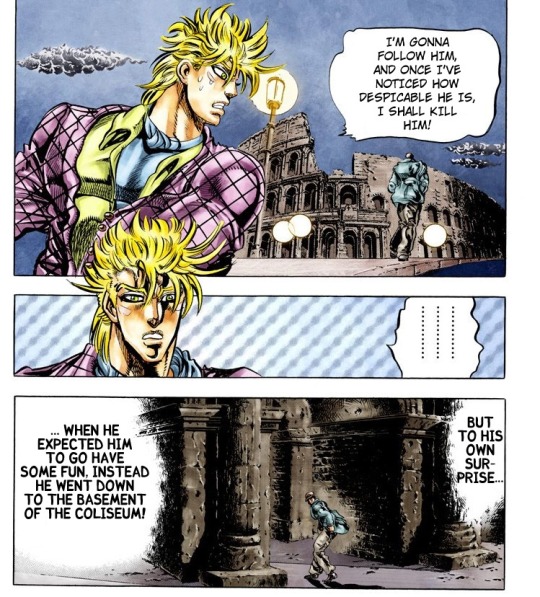
The story is this: Caesar’s father, Mario Zeppeli, was a widower and a good parent, until one day he just ghosted all his kids. He left them plenty of money, but a wicked cousin swindled it away. Neighbors and friends took care of the Zeppeli kids, but Caesar himself became embittered and eventually ended up in an orphanage, and then later he became a street tough in Rome, not unlike a young Speedwagon in London. Caesar resented his father for abandoning the family, and assumed that Mario had left them to pursue some pleasurable life with a woman. He resolved to hunt down Mario and kill him for this, sort of like “A Boy Named Sue”, but when he finally found Mario Zeppeli, he saw him going down into the basement of the Roman Colosseum instead of some brothel.
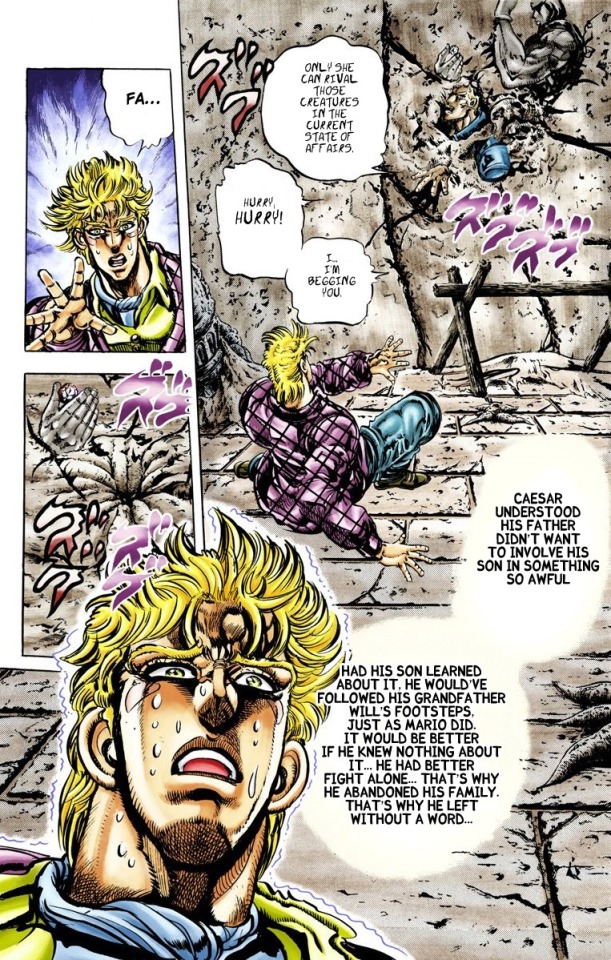
And we already know what’s down under the Colesseum: The three Pillar Men. While following Mario, Caesar discovered the Pillar Men in the wall, and noticed a diamond in Kars’ hand. This was a trap, though, and Mario had to shove Caesar out of the way and get pulled in himself. As Mario explained, the Pillar Men use those precious objects to get humans to take a closer look, and then all these hooks come out to pull them in to be absorbed. This is how the Pillar Men feed during their “hibernation” in the stone.
As he died, Mario pleaded with Caesar to inform a woman named Lisa Lisa in Venice, and to warn her that the Pillar Men would awaken soon. But Mario had no idea that he was speaking to his own son, and it finally dawned on Caesar that Mario had left the family because he knew how dangerous this whole business was, and he had wanted to keep his kids out of it. Awestruck, Caesar suddenly gained a new appreciation for his father, and ended up taking up Mario’s cause.
Which is... a whole lot like the dynamic between Jotaro and Jolyne in Stone Ocean. So there’s some more Part 6 for you. And Mario’s sacrifice resembles Joseph Joestar’s rescue of the Invisible Baby in Part 4. Josuke observed that no one would go so far to save someone they didn’t even know, but Mario Zeppeli did.
The flashback ends with Mario’s death, but it’s not hard to work out the rest of Caesar’s backstory. He went to Venice as instructed, but he must have also told Lisa Lisa that he was Mario’s son, and she must have recognized his nascent Ripple abilities. Eager for help against the Pillar Men threat, she took him on as her student, and trained him through the late 1930′s. And she must have filled him in on how Mario became a Ripple warrior, following in the footsteps of Caesar’s grandfather, Will.
Then Speedwagon and Joseph came to Italy to join forces with Caesar, and it makes some sense why Caesar didn’t respect Joseph very much. The Caesar we see in the flashback looks a lot like Joseph in the early chapters of Part 2: A tough guy, with natural Hamon talents, but no formal training, and no understanding of all the lore surrounding it. Caesar saw Joseph as a reflection of himself at 16, and he must not have liked it at all. Also, this must have made Caesar resentful, because he knew his grandfather died to save Jonathan Joestar, but seeing Joseph probably made him question if that sacrifice was justified.
What confuses me is how all of this European lore gels with the North American lore we saw at the beginning of Part 2. I mean, Speedwagon discovered a Pillar Man in Mexico, and the first thing he did was to call in Straizo. Meanwhile, Lisa Lisa and the Zeppelis had been aware of the other Pillar Men in Rome this whole time. It just seems a bit weird, although Straizo’s sudden betrayal might explain the communication breakdown.
Oh, I should probably also mention something I forgot to bring up earlier: The Pillar Men can’t be destroyed by the Ripple while they’re in their stone forms. Caesar told Speedwagon that he had tried it before, and I’m sure Mario must have done the same.
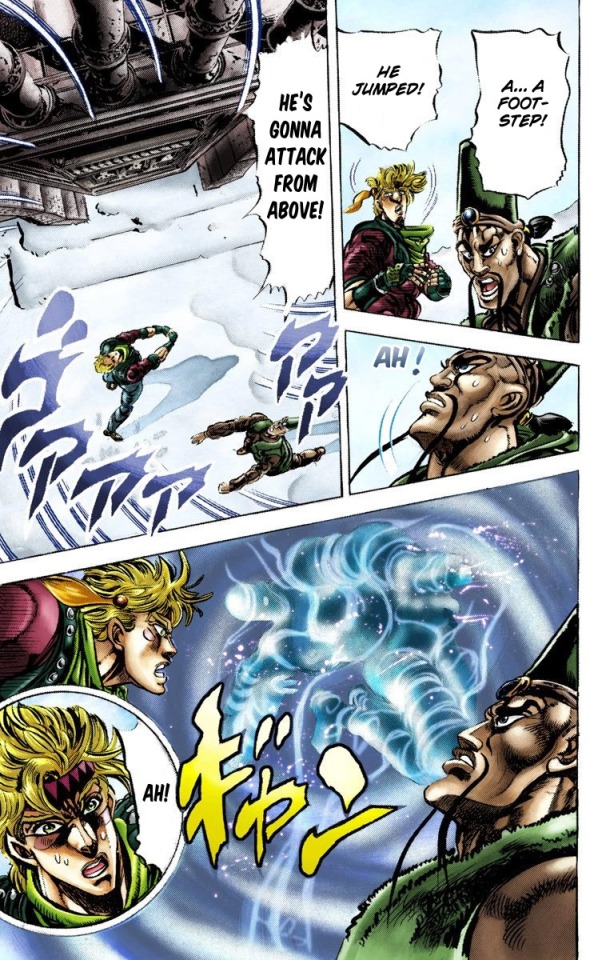
Anyway, now that Joseph knows the whole story of Caesar, he changes his tune and wants to join Caesar on this daring daylight raid on the mansion. He figures that a man like Caesar must have a solid plan to deal with any traps inside the building. And maybe he does, except Caesar can’t even get to the door, because someone’s attacking him in the front yard. Turns out it’s Wammu, not Kars, and his “Wind Mode” allows him to refract sunlight around himself for a short time, making him nearly invisible and also letting him land a surprise attack on the good guys. When Messina catches up to Caesar, Wammu manages to lop off one of his arms.
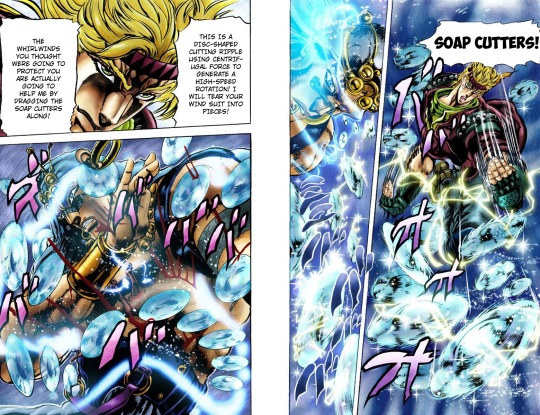
So the situation is a lot more perilous than anyone expected. If Caesar even had a plan, it didn’t involve fighting Wammu outdoors. Undaunted, he releases a volley of soap bubbles charged with Hamon energy. This is a jacked-up variation of his Bubble Launcher technique, but this time the bubbles won’t burst because of all the Ripple power he put into them, and they also spin rapidly like little blades. Wammu’s “wind suit” works against him in this case, because the air currents just drag the “soap cutters” even closer to his body.
So yeah, shades of Part 7 and 8 here. I mean, Gyro Zeppeli’s real name is “Julius Caesar Zeppeli”, so it’s not hard to imagine anything Caesar says and does in Part 2 as a foreshadowing of Steel Ball Run. But he’s even using centrifugal force to strengthen his attacks, a precursor to the “Spin” techniques used by the Zeppelis in the SBR-verse.
I think the soap bubble thing speaks for itself. The “Soft and Wet” Stand in JoJolion uses soap bubbles too. But more than that, I think the Pillar Men have a great resemblance to the villain group in JoJolion. It’s like Araki was trying to come up with ideas for Part 8, and he looked at the Caesar/Wammu fight and decided he wanted More of That. Which is kind of amazing to me, because I always saw Battle Tendency as this “orphaned” JoJo arc, kind of isolated from the rest of the series, but now I’m starting to see that it’s more like a miniature model of the later parts.
Needless to say, this “Soap Cutter vs. Wind Mode” battle looks a lot like the Stand Battles featured in Part 3 and onward. Caesar expected to get to the mansion, only to find an “impossible” scenario: a warrior ambushing him outside. How can this be, when the Pillar Men can’t go out in the daylight? It’s because Wammu’s power lets him do this for short times, but until Caesar figures that out, it gives Wammu the advantage. Then Caesar responds with his own special ability, and uses Wammu’s own technique against him.
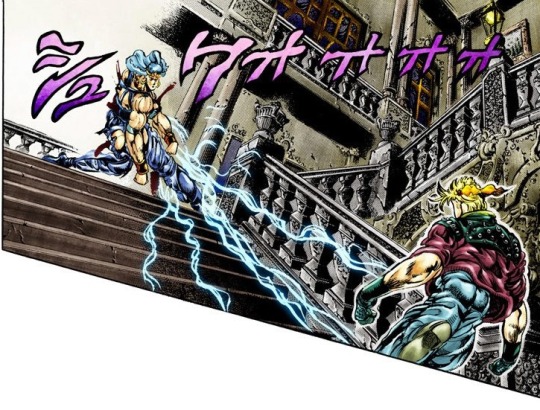
Speaking of Part 3, here’s a shot of Caesar following Wammu into the mansion, and confronting him at the bottom of a flight of stairs. Is Polnareff a secret Zeppeli? Who knows?
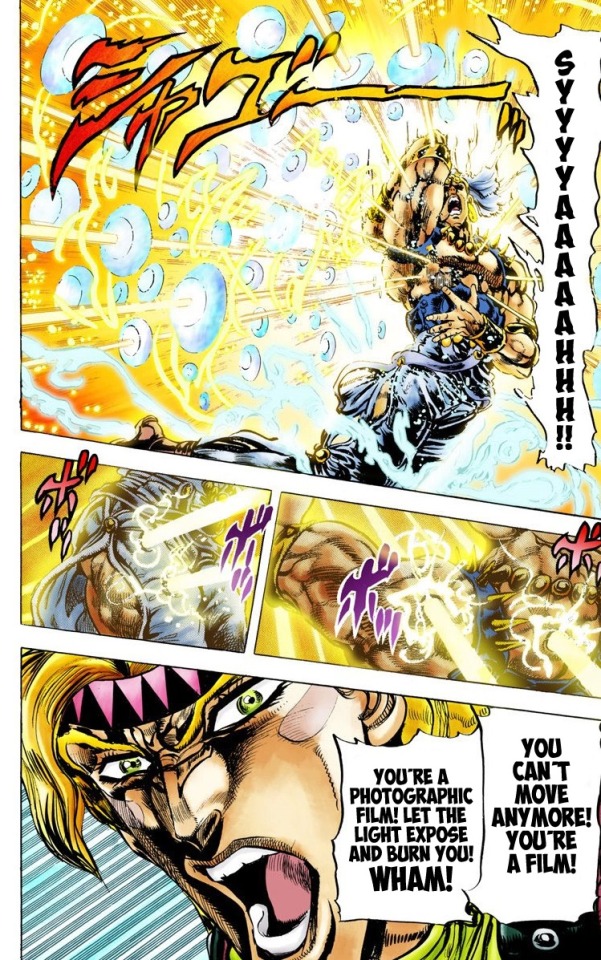
Wammu had to withdraw into the mansion to escape Caesar’s Soap Cutters, and he figures he has a chance to respond with his own big move, but Caesar’s not done coming after him. To get into the mansion, Wammu had to smash a hole in the wall, so Caesar uses the light coming in from that hole to his advantage. He surrounds Wammu with more soap bubbles, but this time they refract and reflect and focus the sunlight onto Wammu’s body.
To be honest, I forgot how much this fight kicks ass. The Pillar Men started out like big bad news, but Joseph crushed Esidisi, and now Caesar is really eating Wammu’s lunch here. Imagine how well the boys would have done if they had ganged up on a Pillar Man.
So Caesar’s got Wammu cornered, so he leaps in to finish him off with a Hamon attack...
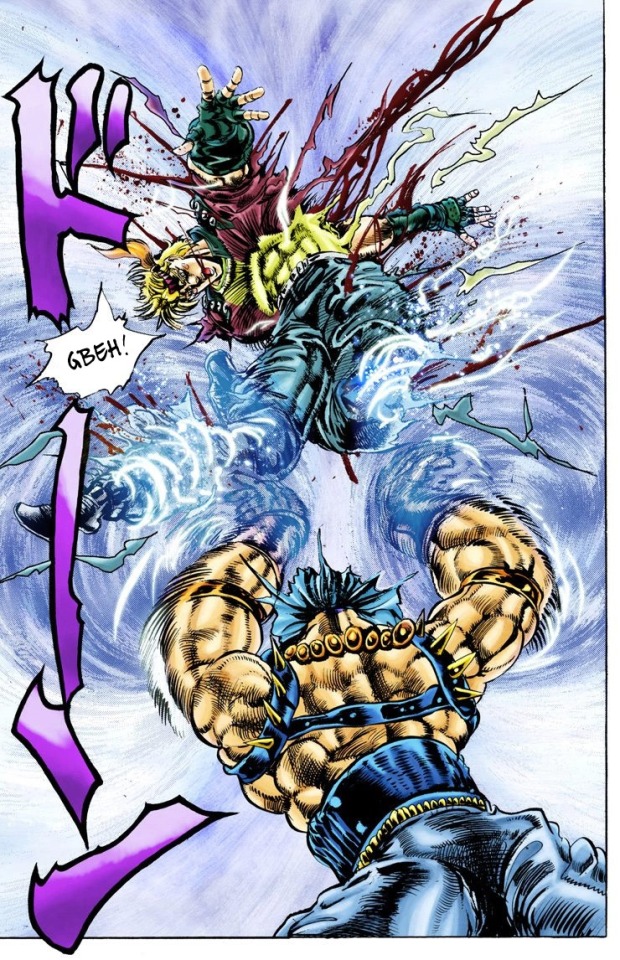
And that turns out to be a huge mistake, because Caesar’s body provides just enough of a shadow for Wammu to recover and fire back with his own windstorm move. This is kind of like how Wammu first appeared. He made that hole, and when the German guy leaned in for a better look, he impaled him with his horn, then spun the horn around to spray blood on all the UV lamps.
Which says a lot about Wammu. Everyone talked about Kars setting up traps in this mansion to foil any daytime attacks, but we never actually saw any traps. Wammu is the trap. All he needs is a shadow and a moment to capitalize on it.
And that’s the fight. Caesar survived the Wind Storm, but he’s too badly hurt to continue. Wammu praises him for giving him the best fight he’s had in millennia, and he even worries about what might have happened if Kars had faced Caesar instead. Wammu thinks Kars still would have won, but he would have gotten hurt worse in the process. That’s saying something, because Wammu got pretty badly hurt himself, so how badly would Kars have fared against Caesar?
One thing that occurred to me while reading the manga for this is that Kars might actually be the weakest Pillar Man in the trio. He’s far above Santana, of course, but it seems pretty clear that Wammu’s the best fighter, and Esidisi’s death was a huge blow to Kars. As soon as he found out, he immediately resolved to kill Joseph because he was too dangerous a threat. This isn’t like when Vegeta loses a subordinate. If you beat Nappa, he’s only mildly impressed, because he’s so much stronger than Nappa that he still doesn’t see you as a threat.
I’d say the Pillar Men are much closer together in terms of power, but it feels like the pecking order is Wammu, then Esidisi, then Kars. Those blades of his are pretty cool-looking, but Wammu’s Wind Mode is much more versatile in a fight. Wammu practically said as much here, but his devotion to Kars prevents him from admitting that Kars would have gotten his ass kicked against Caesar.
So why is Kars in charge? Because he’s the brains of the outfit, naturally. Kars is the one who does all the R&D on these Stone Masks, and Esidisi basically admitted that he has no idea how the Red Stone of Aja will improve the Masks further. Kars understands the Stone Mask technology in ways they can’t even fathom, and his research promises to give them ultimate power, so they’ve been following his orders ever since.
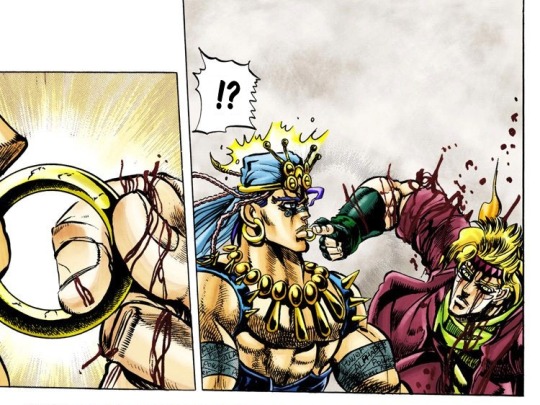
Anyway, Caesar’s beaten, but he still won’t give up. He climbs up the stairs again to keep attacking Wammu, who just sort of stands there looking confused. Then Caesar grabs the piercing from Wammu’s lip, the one that contains the antidote Joseph needs. Wammu doesn’t understand this gesture either, so he just stands there and lets it happen.
This is kind of like when Joseph managed to land a decent blow on Wammu back in Rome, and then he started punching Wammu, only for Wammu to reveal that he allowed himself to be punched to punish himself for taking the hit earlier. I’m wondering if Caesar was counting on Wammu to do the same thing here.
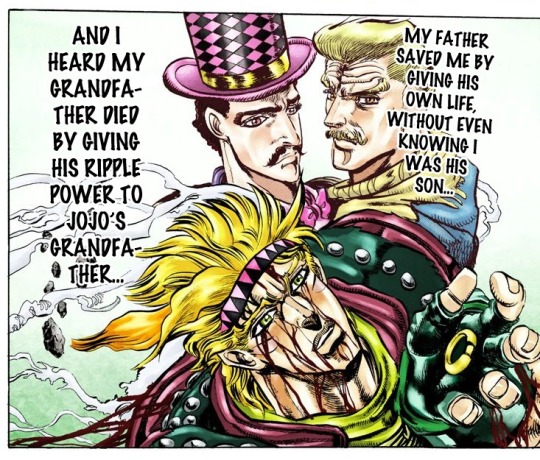
Wammu asks why he would bother with this, and Caesar explains that this is his family’s true heritage. All along, Caesar has been planning to defeat the Pillar Men himself, to avenge his father and grandfather, and to break the curse on their family line. But now he realizes that he’s going to die too, just like they did. His fate is not to succeed where they failed, but instead it’s to carry on their tradition of rescuing others to carry on where they fell. Just as Will Zeppeli passed on his Hamon to Jonathan, Caesar uses the last of his own Ripple to deliver the antidote to Joseph.
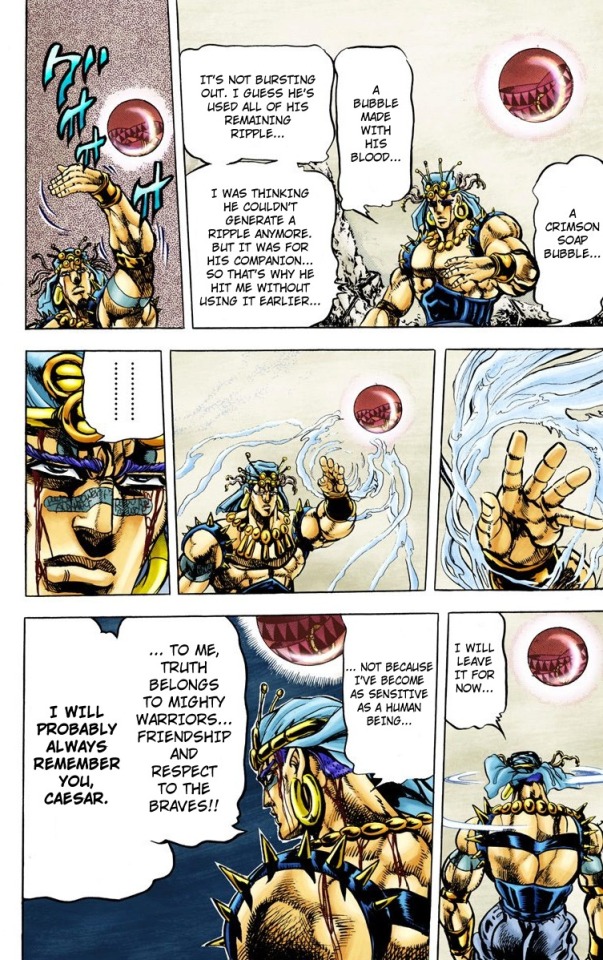
So Caesar makes another soap bubble with his own blood, and puts his headband and the ring inside of it. Wammu considers interfering with this final gesture, but decides against it, because he respects Caesar as a warrior. So he just turns and leaves.
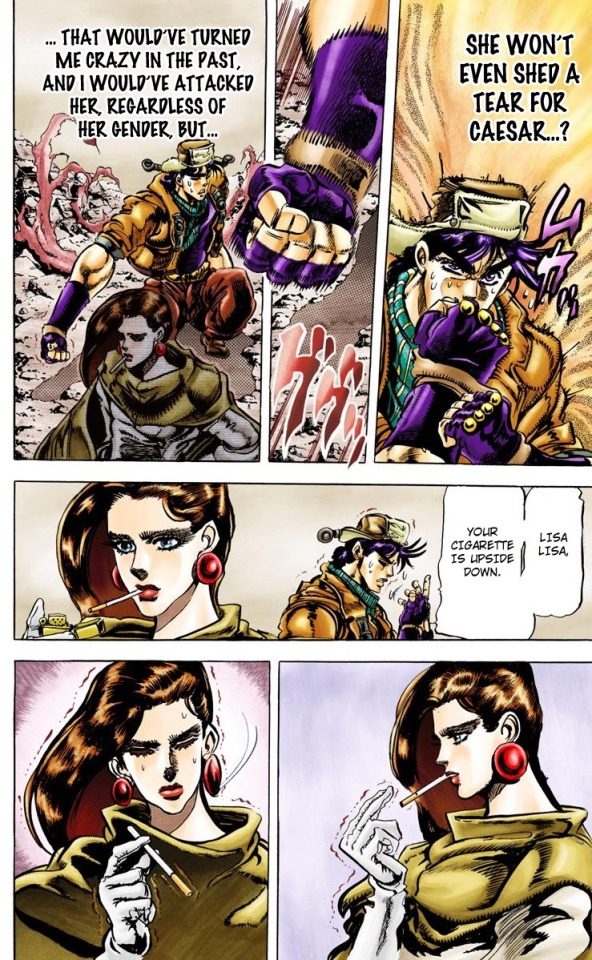
Then Joseph and Lisa Lisa show up. There’s no sign of Caesar or Wammu, but the blood bubble tells the whole story. Joseph is all emotional over this, but Lisa orders him to stay focused. They’re deep in enemy territory, and they can’t afford to grieve. Joseph is upset at first, but then he coolly observes that Lisa’s cigarette is backwards, a sign that she’s not as dispassionate about this as she would like to be. I love this scene. The wiggly lines on Lisa’s hands make the comic version better than the anime.
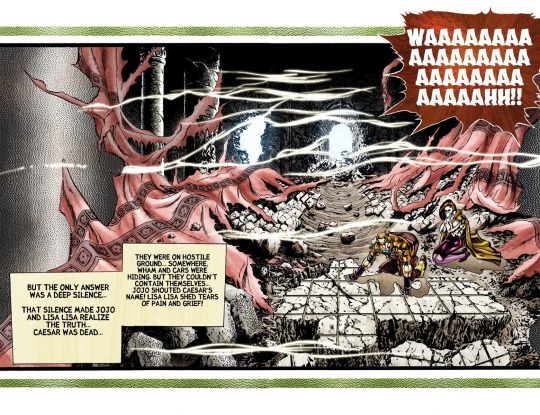
Then they finally notice blood trickling out from beneath a cross-shaped piece of wall. Well, I guess it’s from the wall, but it’s kind of hard to tell what this place looked like before. It fell on Caesar as he died, and now that Joseph and Lisa realize where he is, they both break down in tears.
I’m not a big fan of Caesar. He’s kind of a dick, and most of his more admirable qualities end up getting overshadowed by Joseph’s personal growth. For example, Joseph realizes in this part of the arc that he’s learned to read and empathize with Lisa’s feelings, something Caesar thought he couldn’t do earlier on. On the other hand, this fight marked the end of Caesar’s character arc, and it only happened because he brazenly wandered into a trap. Joseph might regret calling Caesar an idiot, but I think he had the right idea. It didn’t have to go down like this. They could have taken Wammu’s antidote ring some other time. As it is, Joseph still has to fight Wammu anyway, because Caesar’s no longer available to to do it.
However, I think of Caesar when I think about Part 3, because I see Stardust Crusaders as this final chapter of the curse of the Stone Masks, with Joseph coming back to wrap up the last loose end of that whole terrible business. Dio and the Pillar Men killed a lot of people, but Caesar’s the one Joseph actually knew personally. So when I see the Stardust Crusaders heading off to Egypt to wreck Dio’s shit, I tend to think of Caesar as one of the people Joseph is fighting for. I mean, his daughter’s life is on the line in Part 3, so that’s got to be much more important to him, but Caesar was the first friend he lost over these stupid masks, and that’s probably in the back of his mind throughout Part 3. All this trouble, because buttholes like Dio and Kars want to be bigger than everyone else. But their dreams are pathetic compared to the noble sacrifices made by men like Caesar Zeppeli.
Anyway, play the slow, sad part of Roundabout for Caesar.
youtube
#jojo's bizarre adventure#battle tendency#joseph joestar#caesar zeppeli#lisa lisa#wammu#mario zeppeli#will a zeppeli#messina
5 notes
·
View notes
Link
October 28, 2019 at 09:15AM
We don’t exactly need more television in the year 2019, but we sure are getting it. When it launches on Friday, Nov. 1, Apple TV+ will kick off a new generation of streaming services that includes Disney+, debuting on Nov. 12, and HBO Max, which is slated to arrive next year. And while the tech giant’s initial lineup of originals can’t compete with the vast content libraries of its competitors, there is some good stuff in the mix. To help you decide whether to plunk down $4.99 a month for Apple TV+, I screened all of the new series provided for advance review. (Oprah’s Book Club and a handful of children’s programs also set to premiere Nov. 1 were not sent to critics.) Here’s a breakdown of what to watch, what to skip and everything in between.
What to Watch
The Morning Show
Is the flagship show from Apple TV+ everything a drama à clef about morning television in the #MeToo era should be? Probably not. The intersection of feminism, fame and media deserves more depth—and more boldness—than early episodes of The Morning Show provide. Still, it’s pretty enjoyable to watch Reese Witherspoon, Jennifer Aniston and Steve Carell play versions of the sanitized personalities with whom so many of us start our days. A supporting cast that includes Mark Duplass, Gugu Mbatha-Raw and The Diary of a Teenage Girl star Bel Powley is just as strong. Add in solid dialogue, quick pacing and decent production values, and the result is addictive, if not quite revelatory, viewing. (For more on The Morning Show, read my full review.)
The Elephant Queen
A hit at film festivals earlier this year, this nature doc from Victoria Stone and Mark Deeble follows a family of African elephants—led by 50-year-old matriarch Athena—as they trudge from one watering hole to the next, in search of hydration, sustenance and relief from the oppressive heat. The filmmakers get astonishing, often adorable, footage of the pachyderms trekking, playing and caring for one another. And Chiwetel Ejiofor provides gentle narration, introducing many animals who round out the elephants’ ecosystem, from the frogs and turtles who make homes in their wading pools to the dung beetles who… well, you can imagine. One note of caution: Though The Elephant Queen is a family film, and it never devolves into a total downer, Athena’s clan eventually weathers a drought. Stone and Deeble don’t turn away from the tragedies that follow, in what might be a tough watch for very young viewers.
What to Try
For All Mankind
“Red Moon.” That’s the newspaper headline on June 27, 1969 in the America of this solidly constructed alternate-history drama, which games out how the 20th century might’ve gone if the Soviets had beaten the United States to the moon. As a prolonged space race unfolds, creator Ronald D. Moore (the cult TV maker behind Battlestar Galactica and Outlander) imagines a demoralized NASA, where The Killing star Joel Kinnaman’s disgruntled astronaut Edward Baldwin sabotages his own career with a drunken rant to a reporter about the cowardice of the organization’s leaders. Meanwhile, in a subplot that’s sweet and timely but feels tacked on, a Mexican girl crosses the border with outer space on her mind. If you’re intrigued by that premise—and neither exhausted by ‘60s period pieces where brilliant, flawed men brood as brilliant, perfect women endure retro sexism, nor put off by frequent scenes of mission control guys frantically mashing buttons—For All Mankind is going to be your show. If not, there’s little else to see here.
Dickinson
There are straight-faced alternate histories, and then there’s this bonkers show, which poses the question: What if Emily Dickinson, but too much? In an unexpectedly excellent casting choice, Hailee Steinfeld plays the poet as a mercurial, mischievous, proto-goth teen (think Aubrey Plaza with a sugar high) who’s desperate to escape the domestic sphere. Obstacles to her liberation include a mother who’s obsessed with housework (Jane Krakowski in “zany Jenna Maroney project” mode), a fond but sexist dad (Toby Huss) and a brother (Adrian Enscoe) who insists on marrying Emily’s best friend and secret lover (Ella Hunt). Episodes inspired by poems juxtapose 19th-century visuals with contemporary-ish language, pop music and such YA archetypes as mean girls (and an inexplicable gay Japanese teen whose depiction made me cringe). The Dickinson kids throw an opium-fueled rager, grinding to rap in floor-length gowns. Emily escapes her home, one night, to snuggle with the personification of Death—played by an extremely high-looking Wiz Khalifa—in a carriage pulled by ghost horses.
The show is kind of a mess, veering between empathetic depictions of its hero’s struggles against the social norms of her time and slapstick humor that recalls Comedy Central’s costume-drama parody Another Period. Yet it’s never boring. And to the extent that it represents Apple’s bravery in taking on a strange project from a first-time creator, Alena Smith, Dickinson may be the most promising show to come out of the service’s initial lineup.
What to Skip
See
As TV execs scramble to find the next Game of Thrones, you can’t blame a new platform for throwing money at a big, silly genre show. But, at a reported cost of $15 million per episode, See is both bigger and sillier than most of its competition. Starring Khal Drogo himself, Jason Momoa, the sci-fi/fantasy hybrid takes place hundreds of years after a 21st-century virus wiped out all but 2 million humans, leaving those survivors—and, for some reason, all future generations—blind. Society has long since reorganized itself around sightlessness, a process that apparently entailed regressing into primitive, superstitious, warring tribes. Momoa’s Baba Voss is, unsurprisingly, a distinguished warrior with a heart of gold, who’s raising twin babies fathered by his new mate’s old lover as his own. The twist is that the kids and their biological dad, a guy who happens to be the object of a cruel charlatan queen’s (Sylvia Hoeks) obsession, can see.
It isn’t a hopeless setup, though the idea that universal blindness would bring out the worst in humanity for centuries to come may verge on ableism. Yet the execution, particularly in scripts by Steven Knight (of January’s box-office bomb Serenity), is an unmitigated disaster. Speaking with that grand, stagey inflection I think of as Fantasy Voice, characters say things like: “I feel savage intent in the air.” Sex scenes, including what may well be the most awkward masturbation sequence in the history of television, are uniformly creepy. The plot has more holes than a sieve. Aside from Momoa doing what he does best—fighting, grunting, snuggling—Alfre Woodard gives the only memorable performance. Costumes look recycled from a dozen medieval or post-apocalyptic movies, though the queen could be an Anthropologie model. Director Francis Lawrence (who helmed the final three Hunger Games movies) gets in some lovely nature shots, but the massive amount of screentime devoted to combat and foot travel can be mind numbing. Not to put too fine a point on it, See is one of the worst TV series I’ve seen in years.
0 notes